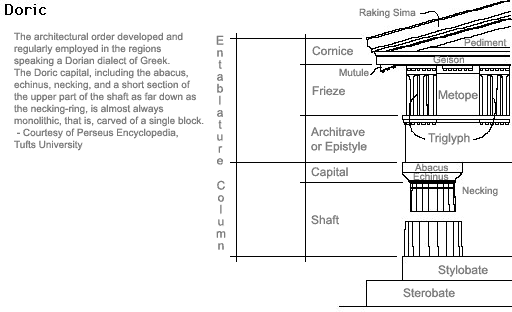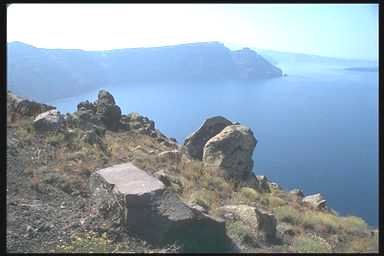

Greek Art
The villages of the ancient Aegean world were organized into independent city-states,
built upon a hilltop as a fortified acropolis, in th 9th and 8th centuries BCE.
This newly developed Greek civilization depended heavily upon trade with other
regions, and their influence, particularly in the arts, spread to all corners
of the Mediterranean and beyond. Ruled first by aristocratic councils and then
tyrants, the Greeks eventually developed the first form of democracy with the
help of the leader Kleisthenes. Though each city-state was independent, they
shared a common language and culture, as well as developments in art. Their
ideals of sculpture and architecture have dominated art since their introduction.
Greek art can be divided into the Geometric, Archaic and Classical periods.
Geometric (900-700 BCE)
Vases and other forms of pottery discovered from this period are painted with
complex linear decorations. Figures and animals are reduced to simple geometric
forms, and the remaining spaces are filled with abstract forms. Figures are
shown in a "subtly twisted perspective" reminiscent of the more severe
Egyptian pose (Stokstad, 96). Small figurines were also produced in wood, ivory,
clay and bronze. Though reduced to simple geometric forms, these votive statues
are "charged with energy" (Stokstad, 96).
Archaic (600-480 BCE)
The earliest Greek temples date from this period, and serve as an introduction
to the ideals of architecture perfected in the Classical period. The temple,
built as a home and treasury to a particular god or goddess, was divided into
a main room (cella or naos) and a vestibule (pronaos). Surrounded by a single
or double row of columns (peristlye), in one of the three orders (Doric, Ionic,
Corinthian), this structure was often decorated with either relief or free-standing
sculpture (on the metopes and pediments). Freestanding statues, lifesize or
larger, were sometimes placed at the entrance. The female statue (kore) and
male statue (kouros) serve as an introduction to the Greek ideal of the human
form. The anatomy is depicted accurately, though the forms are reduced to balanced,
geometric patterns. The large eyes and archaic smile characterize
statues from this period. Male figures are shown nude, while females are usually
dressed.
Vase painting from the archaic period presents a story, or narrative, using
larger-scale figures than the geometric style. The single image, presented in
a clear composition, is executed in either the black-figure (figures
painted in black) or red-figure (figures left unpainted) style. The
story of "The Suicide of Ajax" was painted on an amphora (large storage
jug), and scenes from a bronze foundry were painted on a kylix (two-handled
drinking cup) (Stokstad, 101).
Early Classical (480-450 BCE)
During this transitional period the Greeks banded together to fight against
the invading Persian army. An increase in naturalism is displayed in both painting
and sculpture."Artemis Slaying Actaeon," painted on a krater (bell-shaped
bowl), shows an increased naturalism in the figures and drapery, as well as
a "sense of balance and order" which "adjusts to the actions
of the figures" (Stokstad, 102). Freestanding sculpture moved from the
stiff, simple kore or kouros to the "Kritios Boy," whose facial features,
musculature and have become more natural and fluid. The engaged leg supports
his weight while the other bends slightly. Bronze hollow-casting led to "more
complex and even off-balance action poses" (Stokstad, 104). The "Riace
Warriors" display a more developed naturalism and attention to detail.
The "Charioteer" shows a greater understanding of drapery.
High Classical (450-400 BCE)
The "golden age," occuring even amidst internal war, marks the greatest
developments of Greek and and architecture. The Acropolis at Athens is home
to the Parthenon, one of the most complex and widely influencial works of architecture
ever created. Built by Kallikrates and Iktinos, and decorated by Pheidias, the
Parthenon's refinements in detail counteract optical illusions and give it a
sense of buoancy and an organic nature. Sculpture in the round on the pediment
portrays the birth of Venus, while the Doric frieze tells stories of human victory.
The continuous Ionic frieze shows the Panathenaic procession. The Erechtheion
introduces the caryatid (sculpted women serving as columns) on the "Porch
of Maidens" (Stokstad, 110). The Temple of Athena Nike contains the relief
panel, "Nike Adjusting Her Sandal," admired for the delicate and light
treatment of the drapery.
Greek sculptors combined the most desired ideals of human beauty into a single
idea of perfection. Polykleitos then developed a set of mathematical rules (c.
450 BCE) for the ideal human form, which became "The Canon." "Spear
Bearer" displays these ideals in a more dynamic pose than even the Kritios
Boy.
Late Classical (400-323 BCE)
Though this period was particulary turbulant, falling under control of the Spartans,
then Macedonia, and finally the empire of Alexander the Great, Greek art continued
to develop. The Ionic and Corinthian orders were favored in architecture and
a new canon was developed in sculpture. The figure became more elongated with
a smaller head and a more pronounced S-curve pose. Contrasts in texture and
deep folds in draperies created a more life-life appearance. The nude female
was introduced by Praxilteles with his sculpture of "Aphrodite." Lysippos
was known for his monumental statues of Zeus and Alexander the Great.
Hellenistic (323-? BCE)
Though never unified again by government, the city-states of Greece remained
tied through art and culture. Artists began exploring more everyday themes,
more unique attributes and emotions, and melodramatic poses. Idealized beauty,
such as "Aphrodite from Melos" and "Nike of Samothrace"
remained, but the poses became much more dramatic. Realistic depictions, such
as "Market Woman" were introduced. All levels of society and people
of unusual physical types were exectued in art. Hellenistic painting follwed
the trend of "dramatic narravtive subject matter," evident in the
battle scene of Alexander the Great and Darius III (Stokstad, 130).
Source: http://www2.students.sbc.edu/hill00/seniorseminar/summary3.html
TERMS
Amphora - ceramic storage jug
Krater - wide-mouth ceramic jug for mixing wine and
water
Black-figure - Archaic period vase painting style
with black figures against a reddish background
Engobe - finer-grain clay "slip” mixture
that oxidizes at different temperatures in kiln to create dark figures; figures
delineated by incising through the slip to red clay beneath
Kore - female statuary figure
Kouros - nude male statuary figure
Encaustic - painting method of mixing pigment with
wax
Acropolis - literally, "high city”
Cella - The principal interior structure at the center of a Greek and Roman
temple within which the cult statue was usually housed. Also called the naos.
(S -G3)
Peristyle - A collonade surrounding a building or court (G9-1103)
Cork
Ionic - second of three Greek Classical construction
"orders" or styles, with presumed origins in Ionia, characterized
by continuous sculptured frieze and columns with volutes
Entablature
Stylobate - topmost part of platform which supports
building construction of Ancient Greek styling
Flutes - vertical radiussed grooves in columns
Echinus
Volutes - spiral capital decoration on Ionic columns
Architrave
Frieze
Cornice
Pediment - triangular panel of temple's gable end,
usually infilled with sculpture
Triglyphs - tripartate vertically scored alternating
panels along a Doric frieze probably representing timber beams of earlier temples
Metopes - panels between triglyphs with carved figuration
Caryatids - female figures as columns
Red-figure - Archaic period vase painting style with
red figures against a dark background, reverse of black-figure style with background
filled with slip and red figures delineated by painting the slip
Kylix - wide-mouth two-handled drinking cup
Contrapposto - figure positioning where the body's
weight is placed on one leg with a corresponding shift in shoulders and hips
Lost wax casting - method of creating metal statuary
where wax creates a "negative" mold between two layers of clay and
then is replaced with hot molten metal
Canon - artistic standards, a
set of mathematical rules (c. 450 BCE) for the ideal human form
Hydria - three-handled ceramic jug for carrying water
Corinthian - third of Greek Classical construction
"orders," or style, characterized by increased ornamentation over
the Ionic and by "acanthus" capitals on columns
Gigantomachy - scene depicting battles between Greek
gods and giants
Centauromachy - scene depicting battles between Centaurs
and Lapiths
Amazonomachy - scene depicting battles between
Greeks and Amazons
Temenos - a sacred enclosure surrounding temple or other holy spot
Embolos - a collonnaded street
Tetraprostyle - said of a classical temple having a portico of four columns
in front of the cella or naos
SLIDES
Geometric 900 - 700 BCE
Geometric Krater, from Dipylon cemetery, Athens, 3’4” c. 740 B.C.
Dipylon Vase, amphora, Dipylon cemetery, Athens, 61” c. 750 B.C.
Bronze horse, c. 750 - 730 B.C.
Orientalizing 700 - 600 BCE
Corinthian black-figure amphora, from Rhodes, 1’ 2”, c. 625 - 600
B.C.
Lady of Auxerre, Limestone, 2’ 1 1/2”, c. 650 - 625 B.C.
Archaic 600 - 480 BCE
Kouros, Marble, 6’ 1/2” c. 600 B.C.
Calf-bearer, (Moschophoros), from the Acropolis, Athens, Marble, 5’ 5”,
c. 560 B.C.
Kroisos from Anavysos, Marble, 6’ 4”, c. 530 B.C.
Peplos Kore, from the Acropolis, Athens, Marble, 4’, c. 530 B.C.
Kore, from the Acropolis, Athen, Marble, 1’9 1/2” c. 510 B.C.
Temple of Hera I, Paestum, c. 550 B.C.
West pediment of the Temple of Artemis, Cork, Limestone, 9’ 4” c.
600- 580 B.C.
Gigantomachy, detail from north frieze, Siphnian Teasury, Delphi, 2’ 1,’,
c. 570 B.C.
Francois Vase, by Kleitias & Ergotimos, krater, 2’ 2”. c. 570
B.C.
Dionysus in a Ship, by Exekias, kylix, 1’ c. 570 B.C.
Three revelers, by Euthymides, amphora, 2’ c. 510 B.C.
Dying Warrior form the east pediment, Temple of Aphaia, Aegina, 6’ 1,’
c. 490 -480 B.C.
Early & High Classical 480 - 400 BCE
Kritios Boy, from the Acropolis, Athens, Marble, 2’ 10” c. 480 B.C.
Charioteer, dedicated by Polyzalos of Gela, Delphi, Bronze, 5’ 11”
c. 470 B.C.
Zeus of Poseidon, Bronze, 6’ 10 ‘½. 460 -450 B.C.
Diskobolos (Discus Thrower), by Myron, 5’ 1,’, c. 450 B.C.
Doryphoros (Spear Bearer), by Polykleitos, 6’ 11”, c. 450 - 440
B.C.
Works from the Athenian Acropolis
Parthenon, by Iktinos and Kallikrates, (Temple of Athena), Acropolis Athens,
c. 447 -438 B.C.
Athena Parthenos, by Phidias, 38’ c. 438 B.C.
Details from Panathenaic Festival procession frieze, 3’ 6” c. 447-
438 B.C.
Propylaia, by Mnesikles, c.437 - 432 B.C.
Temple of Athena Nike, by Kallikrates, c. 427 -424 B.C.
Erechtheion, c. 421 - 405 B.C.
Late Classical 400 - 323 BCE
Aphrodite of Knidos, by Praxiteles, 6” 8” c. 350-340 B.C.
Hermes and the infant Dionysos, by Praxiteles, from the Temple of Hera, Olympia,
7’ 1” c. 340
Apoxigomenos (Scraper) by Lysippos, 6’ 9” c. 330 B.C.
Battle of lssus, by Phioxenos of Eretria, 8’ 10” x 16’ 9”,
c. 310 B.C.
Hellenistic Period 323 - 31 BCE
Altar of Zeus, Pergamon, c. 175 BCE
Athena battling Alkyoneos, detail of the gigantomachy frieze, Altar of Zues,
7’ 6”
Dying Gaul, Epigonos?’, 3’ 1/2” c. 230 -220 B.C.
Nike of Samothrarce, 8’ 1” c. 190 B.C.
Seated Boxer, Bronze, 4’ 21/2” c. 100-50 B.C.
Laocoon and his sons, by Athanadoros, Hagesandros, and Polydoros, 7’ 101/2”
first cent. A.D.
Links:
The Parthenon
http://academic.reed.edu/humanities/110Tech/Parthenon.html
Parthenon and Acropolis photos page
Greek Temple Construction
http://www.roanoke.edu/gst/GreekTemple.htm
"The Sole Witness": The Periclean Parthenon
Text of Hum 110 Lecture, 23 October 1995
by Minott Kerr, Visiting Assistant Professor of Art History and Humanities
http://www.reed.edu/~mkerr/papers/Parth95.html
Korous Lecture
by Minott Kerr, Visiting Assistant Professor of Art History and Humanities
DJB Quick Notes:
"Kristios Boy," more realistic kourous
Temples of interest:
Temple of Artemis, Corfu, 600- 580 B.C., pediment: Medusa
Siphnian Teasury, Delphi, 570 B.C., frieze: Gigantomachy
Temple of Aphaia, Aegina, 490 - 480 B.C., pediment: Dying Warrior, Herakules/archer
Temple of Zeus, Olympia, 468 - 460 B.C., pediment: Apollo, Battle of Lapliths and Centaurs, Hippodaemia and Centaur
Parthenon, Athens, 447 - 438 B.C., frieze on cella: Procession; east pediment: Three goddesses, Dionysos/Herakles; metope: Laplith and Centaur
DJB In-Depth Notes:

